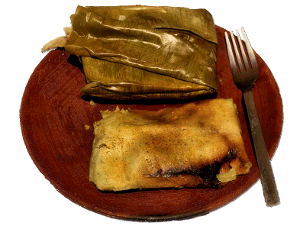Tamale

Wrapped and unwrapped tamales Oaxaqueños (from Oaxaca, Mexico) filled with mole negro and chicken
|
|
| Course | Main course |
|---|---|
| Place of origin | Mesoamerica |
| Region or state | North America, Central America |
| Main ingredients | Corn masa, banana leaves |
| Variations | corn husks |
| 110 kcal (461 kJ) | |
| |
|
A tamale (Spanish: tamal, Nahuatl: tamalli) is a traditional Mesoamerican dish made of masa or dough (starchy, and usually corn-based), which is steamed in a corn husk or banana leaf. The wrapping is discarded before eating. Tamales can be filled with meats, cheeses, fruits, vegetables, chilies or any preparation according to taste, and both the filling and the cooking liquid may be seasoned.
Tamales originated in Mesoamerica as early as 8000 to 5000 BC.Aztec and Maya civilizations, as well as the Olmeca and Tolteca before them, used tamales as portable food, often to support their armies, but also for hunters and travelers.
The diversity of native languages in Mesoamerica led to a number of local words for the tamal, many of which remain in use. The Spanish singular of tamales is tamal. The English word tamale differs from the Spanish word by having a final vowel.
In the pre-Columbian era, the Aztecs ate tamales with these ingredients: turkey, flamingo, frog, axolotl, pocket gopher, rabbit, fish, turkey eggs, honey, fruits, squash and beans, as well as with no filling. Aztec tamales differed from modern tamales by not having added fat.
In the pre-Columbian era, the Mayas ate tamales and often served them at feasts and festivals. The Classic Maya hieroglyph for tamales has been identified on pots and other objects dating back to the Classic Era (200–1000 CE), although it is likely they were eaten much earlier. Several different types of tamales are mentioned in Dresden Codex: iguana tamales, turkey tamales, deer tamales, and fish tamales.
...
Wikipedia
